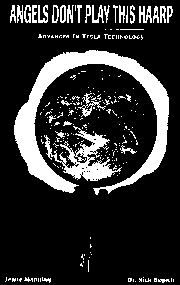Angels Don't Play This HAARP
Book Excerpt
Sent by Sharon Shea

Available by Visa or Mastercard
Call 24 Hrs., voice mail system in U.S.A.
1-907-249-9111
Order by Fax 1-907-696-1277
Or Mail request to:
Dr. Nick Begich
P.O.Box 201393
Anchorage, Alaska 99520
USA
From National Defense to the Justice Department
On July 21, 1994, Dr. Christopher Lamb, Director of Policy Planning, issued
a draft Department of Defense directive which would establish a policy for
non-lethal weapons. The policy was intended to take effect January 1, 1995,
and formally connected the military's non-lethal research to civilian law
enforcement agencies.
The government's plan to use pulsed electromagnetic and radio frequency systems as a nonlethal technology for domestic Justice Department use rings the alarm for some observers. Nevertheless, the plan for integrating these Systems is moving forward. Coupling these uses with expanded military missions is even more disturbing. This combined mission raises additional constitutional questions for Americans regarding the power of the federal government. [294]
In interviews with members of the Defense Department the development of this policy was confirmed.[295] In those February 1995, discussions, it was discovered that these policies were internal to agencies and were not subject to any public review process.
In its current draft form, the policy gives highest priority to development of those technologies which are most likely to get dual use, i.e. law enforcement and military applications. According to this document, non-lethal weapons are to be used on the government's domestic "adversaries". The definition of "adversary" has been significantly enlarged in the policy:
"The term 'adversary' is used above in its broadest sense, including those who are not declared enemies but who are engaged in activities we wish to stop. This policy does not preclude legally authorized domestic use of the nonlethal weapons by United States military forces in support of law enforcement." [296]
This allows use of the military in actions against the citizens of the country that they are supposed to protect. This policy statement begs the question; Who are the enemies that are engaged in activities they wish to stop, what are those activities, and who will make the decisions to stop these activities?
An important aspect of non-lethal weapon systems is that the name non-lethal is intentionally misleading. The Policy adds, "It is important that the public understand that just as lethal weapons do not achieve perfect lethality, neither will 'non-lethal' weapons always be capable of precluding fatalities and undesired collateral damage". [297] In other words, you might still destroy property and kill people with the use of these new weapons.
Pentagon officials said they would like to get $41 million in 1995, for developing these weapons which include their electromagnetic pulse systems.[298] This "meager" sum has a good deal of reach, because it is for implementing already understood technology, for building prototype weapons out of mostly "off the shelf" parts. The only challenge would be putting them together. The basic research for these technologies was done with "black budget" money. (These are funds which are so secret even the Congress does not know how the money will be spent, behind which organizations like the C.I.A., government laboratories run by the military and other intelligence organizations, hide their programs.) The Pentagon actually received $50 million to be used jointly with the Department of Justice in developing these "non-lethal" weapons. [299]
In press statements, the government continues to downplay the risks associated with such systems, even though the lethal potential is described in context of their own usage policy. In Orwellian doublespeak, what is nonlethal can be lethal!
The development of these technologies is being jointly managed by the Non-Lethal Weapons Steering Committee, which is co-chaired by the Undersecretary of Defense for Acquisition and Technology and the Office of the Assistant Secretary of Defense for Special Operations and Low-Intensity Conflict. [300] This crystallizes the new Justice Department and Department of Defense alliance for future law enforcement and military initiatives, in the United States.
The weaving together of Department of Defense missions with civilian Department of Justice missions is unprecedented. Not since the civil war has the military machinery -- except in very limited riot control actions -- been turned against United States citizens since the Civil War. The idea of using these dangerous and intrusive Systems is counter to good public policy. This raises serious questions regarding use of our Department of Defense for domestic police actions. which may be a violation of constitutional law by being in conflict with the narrowly-defined federal use of the military "for the national defense."
Notes
294. Department of Defense Directive, Policy for Non-Lethal Weapons, Office of the Assistant Secrefary of Defense, Draft July21, 1994.
295. Interviews in late February by Nick Begich.
296. Department of Defense Directive, Policy for Non-Lethal Weapons, Oflice of the Assistant Secretary of Defense, Draft July21, 1994.
297. Ibid.
298. The wall Street Journal, "Nonlethal Arms, New Class of weapons Could Incapacitate Foe Yet Limit Casualties, by Thomas E. Ricks, January 4,1993, page Al and A4.
299. Warren Hough, "High-Tech Civilian Control Studied; Secret Pentagon - DOJ Memo of understanding, 'Non-lethal' weapons under development, are being added to the government arsenal in its war against its own citizens.", The Spotlight, July 31,1995.
300. Perry Plans to Launch Nonlethal Warfare Effort, Defense News September 19-25,1994.